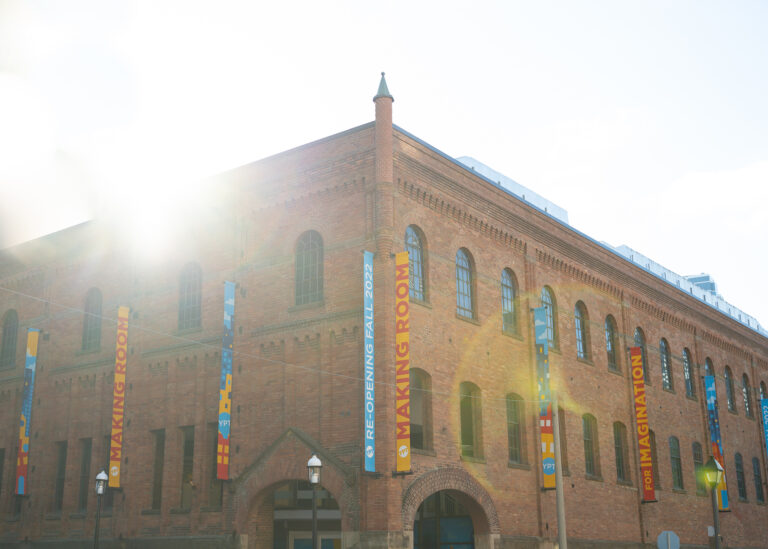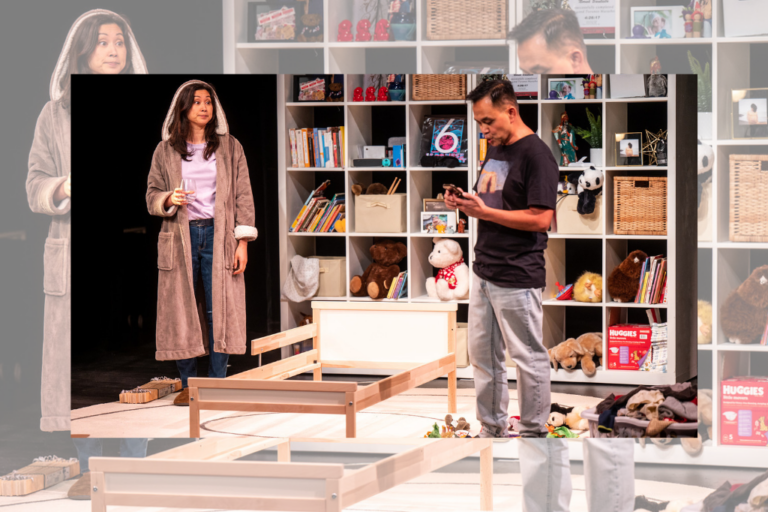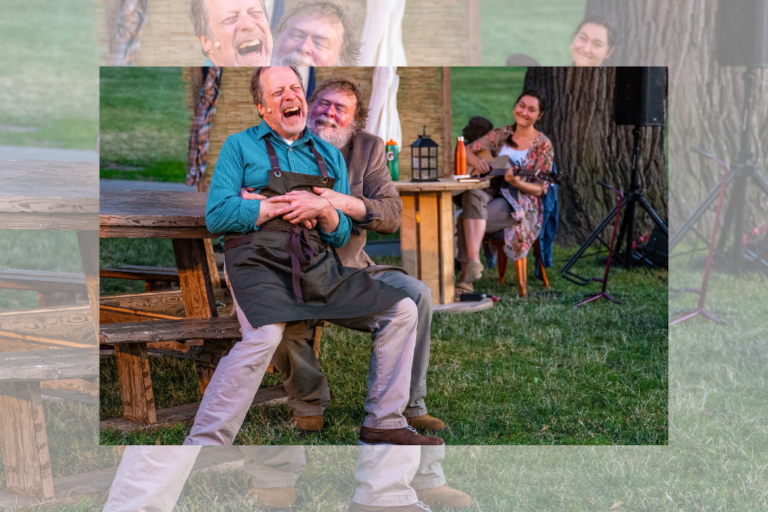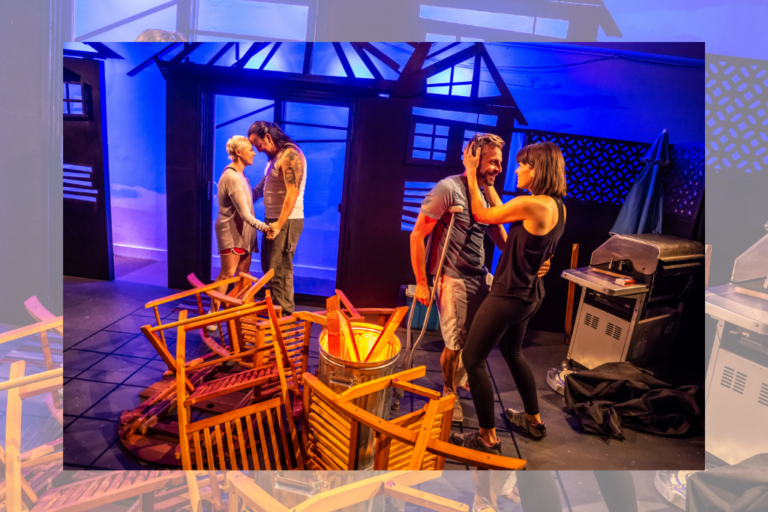REVIEW: Festival TransAmériques — Weekend Two
Bonjour hi encore – et mon dieu, so many festivals!
Hot off the joyous, exhausting marathon that was the Stratford Festival’s opening week, and after a brief hiatus in Toronto to review Soulpepper’s brilliant production of Sizwe Banzi is Dead for the Toronto Star, I hopped on a plane to Montréal to catch three productions in the final week of the 2023 Festival TransAmériques (FTA). During that intense viewing spate at the FTA, the shows started overlapping and informing each other — and that’s no bad thing.
Qaumma — Vinnie Karetak and Laakkuluk Williamson Bathory, Iqaluit
The FTA has made a significant commitment to this interdisciplinary piece by Inuit artists Vinnie Karetak and Laakkuluk Williamson Bathory: they presented it in workshop form in 2022 and this year as a one-hour-long performance. In 2023, Karetak and Charlotte Qamanik perform Qaumma (which means “light” in Inuktitut), with Williamson Bathory as director.
Like many Toronto theatregoers, I became acquainted with Williamson Bathory in her striking and adventurous collaborative piece with Evalyn Parry and others, Kiinalik: These Sharp Tools, in which Williamson Bathory gave an unforgettable performance of uaajeerneq, Greenlandic mask dancing. This involved her painting her face black, putting small balls in her cheeks to further alter her appearance, and climbing all over the audience in a pointedly sexualized manner.
Qaumma is infused with the spirit of uaajeerneq but in a less literal way. The audience sits on four sides of the Studio Hydro-Québec at the Monument-National, surrounding a bare stage with a jagged white shape at its centre – white cloth pulled over a metal or wooden framework to create the shape of an iceberg (set design by Catherine D. Lapointe).
As the show begins, Williamson Bathory walks around the space looking at the audience, meeting many of our eyes, delivering a land acknowledgement. As she noted during an an interview published on the FTA website, the exchange is meant to be challenging, to make the audience experience what it feels like to be colonized, and to underline that we’re implicated in the stories being told.
Williamson Bathory then sits on the balcony and watches the show in the view of the audience, again underlining themes of visibility and surveillance. Karetak starts to circle around the iceberg, telling stories about the resilience of Inuit women in the face of colonization and Christianity. The central story involves his grandmother facing an impossible, Sophie’s Choice-level decision after fleeing an abusive domestic situation with her children, after which she was persecuted by the state.
As he speaks, images appear on the side of the website — old family photographs intercut with images of the Northern landscape (video by Elysha Poirer). A soundscape of electronic music by Aqqalu Berthelsen underscores the action. Qamanik at times emerges from the top of the iceberg and (again) surveils; at one point the pair physically destroy a traditional drum, a wrenching image.
These elements do not sit together easily as a comprehensive, linear piece but rather felt to me like an installation or collage, its jaggedness a form of politicized resistance to Western norms. At the end Williamson Bathory returns to the stage, performs partnered throat singing with Qamanik, and invites audience members to dance with her and the others. There’s no formal ending to the event: We’re left to decide for ourselves what our next moves are, a fitting end to a thought-provoking, unsettling work.
Bronx Gothic — Okwui Okpokwasili, Brooklyn
The next production I saw was on the one hand very different, but I also saw links to Qaumma in its focus on trauma and resilience amongst racialized and minoritized women, and by its interdisciplinary nature. Okwui Okpokwasili, a New York-based artist of Nigerian descent, started performing Bronx Gothic in 2014, and it’s proved so enduringly resonant and successful on the festival scene that she recently handed performance of it to another artist, Wanjiru Kamuyu.
As the audience enters the Espace dance at Édifice Wilder, Kamauyu stands in the far corner of the space, her back to the audience, vibrating. More than vibrating: quaking. Or as Okpokwasili herself describes it, “twerking gone horribly wrong.” She’s standing in a large, somewhat disrupted domestic space: closed high curtains, table lamps and house plants on the floor, many of them overturned (the direction, set, and lighting are all by Peter Born, Okpokwasili’s husband). There’s a stand mic under a spotlight at the centre of the space, in the middle of a little garden patch, a promise that something will happen there.
But first, Kamuyu quakes, for somewhere between ten and 20 minutes. A low-level score of rumbling noise mounts slowly (music is by Born and Okpokwasili). By the time she breaks for the mic, she’s covered in sweat and the audience is wired and attentive.
Kamuyu reads out letters that, it emerges, were exchanged between two pubescent girls in the 1980s Bronx. They’re a very credible combination of raw, naïve, profane, and heartfelt, and something of a not-right narrative eventually emerges about someone’s mother’s boyfriend. It’s not a linear story, though: Bronx Gothic works through an accumulation of episodes and through Kamuyu’s powerful performance as she sings, reads, and moves.
While saying the production is “about” something feels reductive, overall it felt to me like an exorcism of internalized violence and trauma, inviting the audience to reflect on the overfamiliarity of the Black body as the object of a gaze. In the nine years the production has been touring, such concerns have come to the forefront of popular consciousness, so that what might have before seemed revelatory now feels like the further making of a still-too-relevant point. At the centre remains Kamuyu’s indelible, undeniable, shuddering physical presence.
Encantando – Lia Rodrigues, Rio de Janeiro
After these two relatively small-scale, contained works, an explosion of spectacle, movement, and emotion.
On the one hand it feels reductive to turn my short FTA sojurn into a teleological story with a big, summing-up finish; that dramaturgy’s way too old-school for artistic directors’ Martine Dennewald and Jessie Mill’s decolonial, feminist programming. But I can’t deny that Brazilian choreographer Lia Rodrigues’ hour-long-piece felt massively cathartic, while at the same time expressing a politicized spirit that resonated with the other two shows.
The first ten minutes or so of Encantando involves 11 performers slowly unrolling what looks like a massive quilt onto the Usine C floor. They leave and come back out one by one, naked, and crawl under pieces of the fabric; it turns out the quilt is not sewn together but is a patchwork of brightly coloured blankets. A score of music and singing slowly becomes audible and increasingly becomes an integral part of the show’s meaning. It’s a live recording of a protest in Brasilia by Indigenous Mbyá Guaraní people demonstrating for land rights in 2021.
The performers move with the blankets and each other: they make sarongs, turbans, capes, and effigies of swaddled babies with the fabric. Some of the imagery they create challenges binary understandings of gender, with men swaying their backs and swelling their bellies to simulate pregnancy. Some seem to parody stereotypes of Indigenous and racialized peoples: performers go pop-eyed and make their movements purposely simplistic. There are aesthetically beautiful moves, with bodies and fabric making graceful arcs in the air.
As the show goes on, an overall collaborative dynamic emerges: the company are clearly working to an imperative to keep the blankets together as they move into various patterns on the floor. So many meanings emerged from the piece for me: it is a statement about conservation, a demonstration of the power of working together, a celebration of collective self-expression, an invitation (the performers sometimes meet audience members’ eyes) to break down barriers between those who act and those who observe.
Emotion mounted among the audience to the point of becoming almost overwhelming: I wonder if in less Western-traditional settings spectators have rushed the stage during or after the show. Certainly at this performance we were on our feet at the end giving the company ovation after ovation.
With its messages of Indigenous resurgence and ecological preservation, Encantando is a 2023 festival show par excellence, with a co-producer list of Lepagian scale. No North American producers though, and yet still I hope that this gorgeous and timely piece will find its way to more Canadian venues and festivals. It’s essential.
Intermission reviews are independent and unrelated to Intermission’s partnered content. Learn more about Intermission’s partnership model here.















Comments